Editor’s note: The following is extracted from Indian History for Young Folks, by Francis Samuel Drake (published 1919)
The Indian’s style of fighting was suited to the forests in which he roamed. The thicket provided him with an ambush, the tree or rock served him as a shield. Each warrior fought “on his own hook,” singling out some individual opponent, and using every stratagem to outwit and overpower him.
Upon one occasion an Oneida Indian, who had placed a rock between himself and two of his Indian pursuers, putting his hat on the end of his gun-barrel, raised it slowly, as if to obtain a sight of his enemies. The ruse succeeded; both Indians fired, the hat dropped, and rushing forward with exulting yells, expecting to secure a scalp, one was instantly shot down, and the other took to his heels for safety.
This kind of warfare made it necessary for the white man to adopt similar methods, and in this way a hardy, active, and self-reliant body of frontiersmen were trained up, who were of the greatest service in the wars waged by the two races. An organized body of these men was employed in the “Old French War.” They were known as “Rogers’s Rangers,” from their commander, Major Robert Rogers. This celebrated partisan, a native of Dunbarton, New Hampshire, was at this time under thirty years of age. Rough in feature, he was tall and well-proportioned, and was one of the most athletic men of his time, being prominent in all the trials of strength or activity in his neighborhood for miles around.
Rogers possessed great presence of mind, intrepidity, and perseverance, and a plausible address, and had in early life acquired great decision and boldness of character. He was versed in all the arts of woodcraft, was sagacious, prompt, and resolute, yet so cautious as to incur at times the unjust charge of cowardice.
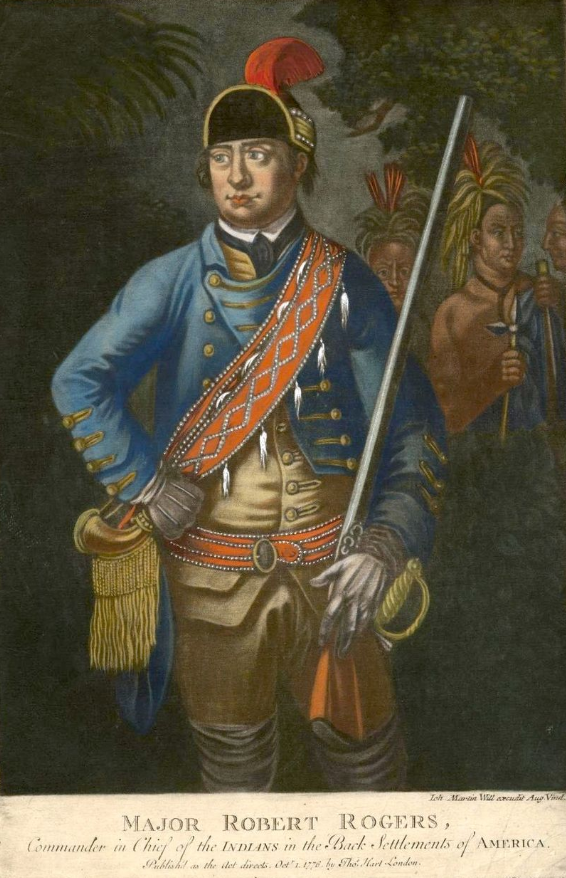
These qualities he displayed on many occasions. Once, when in England, a mail-coach in which he was a passenger was stopped by a highwayman on Hounslow Heath. The robber, thrusting a pistol through the coach window, demanded the purses and watches of the occupants. While the others were delivering up theirs, the bold ranger suddenly seized the robber by the collar, drew him by main strength through the carriage window, and bade the coachman drive on. The highwayman proved to be an old offender, for whose apprehension a reward had been offered by the government.
At a social party of British officers at which he was present, it was agreed by the company that whoever of them should tell the most improbable story should have his bill paid by the others. When his turn came, Rogers stated that his father was shot in the woods by a hunter, who mistook him for a bear; that his mother was followed by a hunter, who mistook her tracks in the snow on a stormy day for those of a wolf; and that he, when a boy, had carried birch-brooms on his back to Rumford, ten miles distant from his father’s house, to be sold, following a path through the woods only marked by spotted trees. The company paid for his dinner, admitting that he had told the “toughest” story. Rogers had only stated the exact truth.
The Rangers were a body of hardy and resolute young men, principally from the vicinity of Amoskeag Falls, New Hampshire, where Rogers had been accustomed to meet them at the annual fishing season, and on whose skill, courage, and fidelity he could implicitly rely. Especially renowned as marksmen, every one of these rugged foresters could hit an object of the size of a silver dollar at a hundred yards. He could follow the trail of man or beast, and endure the extremes of fatigue, hunger, and cold.
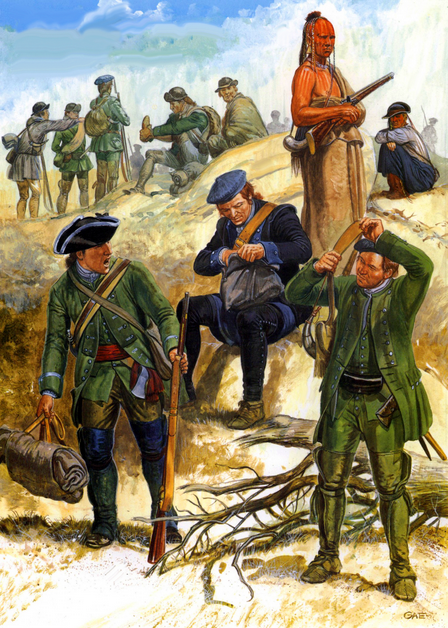
They were constantly employed in watching the motions of the enemy, in pursuing their marauding parties, or in cutting off their convoys of supplies, frequently making prisoners of their sentinels at Ticonderoga and Crown Point. Limited in their expeditions to no season, they made, in winter, long and fatiguing journeys on snow-shoes into the enemy’s country, often encamping in the forest without a fire, to avoid discovery, when the ground was covered with snow, and with no other food than the game they could kill during their march. They were the most formidable body of men ever employed in Indian warfare, and in regular engagements proved themselves not inferior to British troops. From frequent contact with the natives, they were familiar with their language and customs, and their French and Indian foes dreaded them with good reason.
Theirs was a hard life, but the excitement and danger attendant upon it gave it a zest that reconciled these hardy foresters to its toils and privations. There was something singularly attractive to the young frontiersman in the free forest life of the Ranger. To him it was a source of no ordinary enjoyment to scour the forest in search of the Indian foe, but to be able to steal upon him unawares, and to return victorious from an expedition against him, was in the highest degree exhilarating and inspiring.

No hero of romance ever displayed more daring. Danger and death were his constant companions. He defied wounds, capture, torture, mutilation, and never counted the number of his foes until after he had routed them. Where to strike first and most effectively was his only study. Securing his retreat was no part of his strategy; he never measured the distance from his base of operations, for he was his own commissary and quartermaster, carrying his rations on his back, having for his bed the bosom of mother earth, and for his tent the canopy of heaven. His tactics were the maxims of Indian warfare, and he knew his duty so well, and was so self-reliant, that obedience and subordination seemed to him wholly unnecessary. The corps of Rangers always marched silently and with great rapidity, and by the shortest line. Neither forest nor stream presented any obstacle to their progress.
It was in this school that Putnam, Rogers, Stark, Brewer, and others were trained for future usefulness in the struggle for American independence. Several British officers, attracted by this exciting and hazardous, as well as novel, method of campaigning, joined as volunteers in some of their expeditions. Among them was the young Lord Howe, who, during this tour of duty, formed a strong friendship for Putnam and Stark, both of whom were with him when he fell at Ticonderoga shortly afterwards.
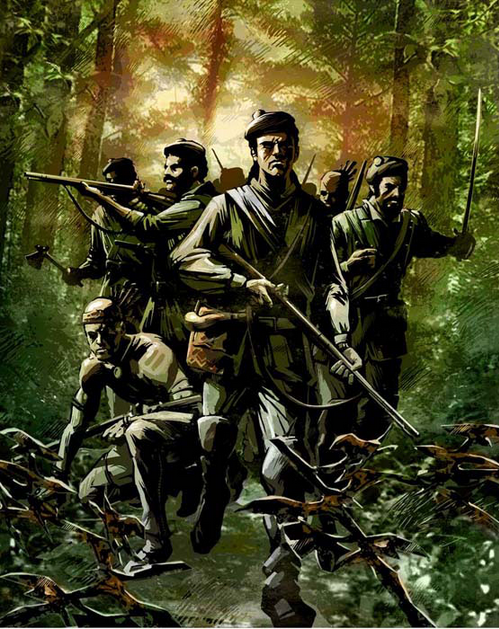
So useful was the corps of Rangers found to be in its very first campaign, that from a single company of sixty men it was at once increased to four, and afterwards to nine companies of one hundred men each, Rogers being promoted to the rank of major. They then were subject to army discipline and the articles of war. Their dress was that of the frontiersman of that day, and uniform in each company. One of these was composed wholly of Indians in their native costume. The weapons of the Ranger were a firelock or fusee, a hatchet, and a long knife. A powder-horn was slung under the right arm. The pack, to which was strapped a blanket, held his provisions, and flint and steel with which to strike fire. Each officer carried a pocket-compass.
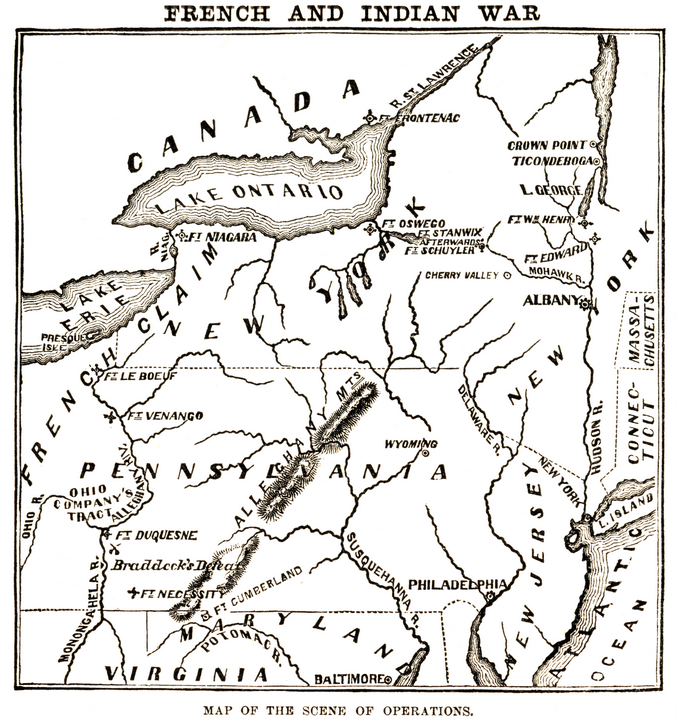
The arena of their exploits was the vicinity of Fort Ticonderoga, at the northern extremity of Lake George, forty miles from Fort William Henry, a British work at the south end of the lake. The waters of Lake George and Lake Champlain formed the main avenue of communication between Canada and the English colonies. Crown Point, on Lake Champlain, and Ticonderoga, both in the hands of the French, were the keys to this important thoroughfare, over which, at all seasons of the year, the hostile parties of French and Indians passed. Snow-shoes rendered their progress easy in winter; at all other times they glided over its placid waters with ease and celerity in their light birch canoes. Fort Edward, on the Hudson, and Fort William Henry, fifteen miles farther inland, were the two most northerly of the British frontier posts.
![]()
This picturesque region, with its mountains, lakes, and forests, yet retains much of its original character, and it is not easy for the tourist who to-day rambles amid its peaceful solitudes to realize that this lovely and romantic region could ever have been the scene of such fierce strife as was waged here little more than a century ago.
Rogers’s lieutenant was John Stark, afterwards the hero of Bennington. When in his twenty-fourth year, while out with a hunting party, he, with a companion named Amos Eastman, was captured by some St. Francis Indians and taken to their village. The others of the party, David Stinson and William Stark, his brother, were in a boat at the time of the capture, and John was ordered by the Indians to decoy them to the shore. Instead of doing so, he shouted to them to save themselves by pulling to the opposite shore. They did so, and the Indians fired upon them, but John knocked up the muzzles of their guns, and by this piece of audacity saved the life of his brother, who escaped. John was severely beaten by his captors for this performance, but was afterwards kindly treated by them.
At the Indian village the prisoners had to run the gauntlet. For this cruel sport the young warriors of the tribe were ranged in two lines, each armed with a rod or club to strike the captive as he passed them, singing some provoking words taught him for the occasion, and intended to stimulate their wrath against the unfortunate victim. The latter carried a pole six or eight feet long, with the skin of some bird or animal attached to it.
Eastman, who was the first to undergo the ordeal, was terribly mauled. Stark, whose pole was ornamented with a loon’s skin, making a sudden rush, knocked down the nearest Indian, and wresting his club from him, struck out right and left, dealing such vigorous blows at each turn that he made it lively for the Indians without much injury to himself. This feat greatly pleased the old Indians, who enjoyed the discomfiture of their young men. When the Indians directed him to hoe corn, Stark cut up the young corn, and flung his hoe into the river, declaring that it was the business of squaws, and not of warriors, to hoe corn. Pleased with his boldness, the Indians released him from his task. He was adopted into the tribe by the sachem, and treated with genuine kindness as long as he remained with them. He was subsequently ransomed on payment of £100, and returned home.
During the Revolutionary War, Stark’s services were rendered at the most critical moments, and were of the highest value to his country. At Bunker Hill he commanded at the rail fence on the left of the redoubt, holding the post long enough to insure the safety of his overpowered and retreating countrymen. At Trenton, where the capture of the Hessian garrison revived the sinking spirits of the Americans, he led the van of Sullivan’s division; and at Bennington he struck the decisive blow that paralyzed Burgoyne and made his surrender inevitable.
While stationed at Fort William Henry, in March, 1757, Stark’s vigilance saved the fort from surprise and capture. It was then garrisoned by an Irish regiment and one hundred and fifty Rangers, many of whom were of the Scotch-Irish race. Overhearing his men planning a celebration in honor of St. Patrick, he ordered that no grog should be served to them on the evening of the 17th without his written order. Feigning a lame wrist, he refused all entreaties for such an order. Meantime the Irish soldiers, having received an extra supply of rum, held a carouse lasting through that night and the following day. Being totally unfit for duty, the Rangers, who were sober; supplied their places as sentinels. At two o’clock on the morning of the 18th a French army of two thousand five hundred men, under De Vaudreuil, with a large Indian following, knowing the Irish custom, and expecting to find the garrison intoxicated, approached within thirty rods of the fort. Five hundred picked men then advanced with scaling ladders to the attack. The Rangers were on the alert, and poured a destructive volley into their ranks, while the guns of the fort opened with grape and canister upon the column in the rear. Confused and mortified, the French fell back greatly demoralized. On the following day a general attack was made, which was gallantly repulsed, and after a five days’ siege the enemy withdrew. The fort was soon afterwards captured by Montcalm, by whom it was entirely destroyed. The Rangers were engaged for the first time in the action at Lake George, between General Johnson, and the French and Indians, under Baron Dieskan. Rogers and a part of his command were absent at the time on a scouting expedition up the Hudson.
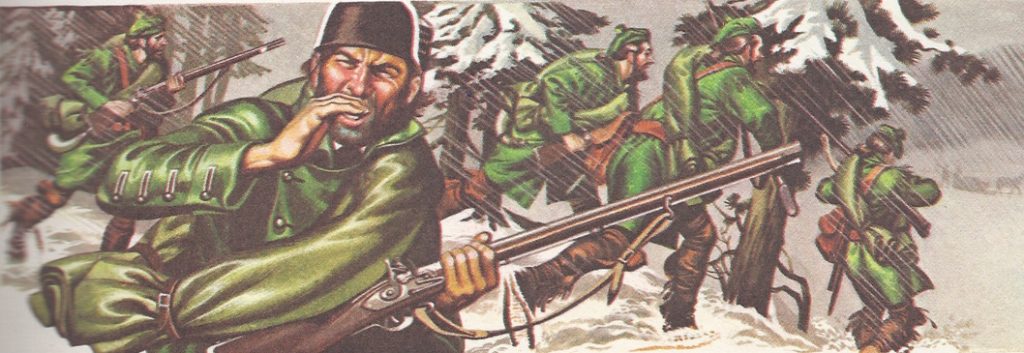
In January, 1757, a detachment of Rangers marched from Fort William Henry to intercept supplies passing between Crown Point and Ticonderoga. Half-way between these posts they captured several sleds and destroyed their loading. One sled escaped, and was driven swiftly back to Ticonderoga. Knowing that the garrison would be immediately notified of their presence, the Rangers at once began their retreat. As it was raining, they paused at their last night’s camping-ground, where their fires were still burning, long enough to dry their guns and put in fresh pruning. They marched in single file, Rogers in front, Stark in the rear, and Captain Spekeman in the centre. At two in the afternoon, when only three miles from Ticonderoga, they were suddenly attacked by a force of French and Indians of three times their own number, concealed in their front. A desperate and sanguinary encounter now took place. The enemy, who were drawn up in the form of a crescent upon the summit of a hill, saluted the Rangers with a volley that proved fatal to several, and wounded Rogers in the head. He ordered his men to retire to an opposite eminence, where Stark and Brewer had made a stand with forty men to cover the retreat. Stark repulsed the enemy by a brisk fire from his position, thus affording the retreating Rangers an opportunity to post themselves to advantage. He himself took post in the centre, and placed reserves to protect the flanks and watch the movements of the enemy.
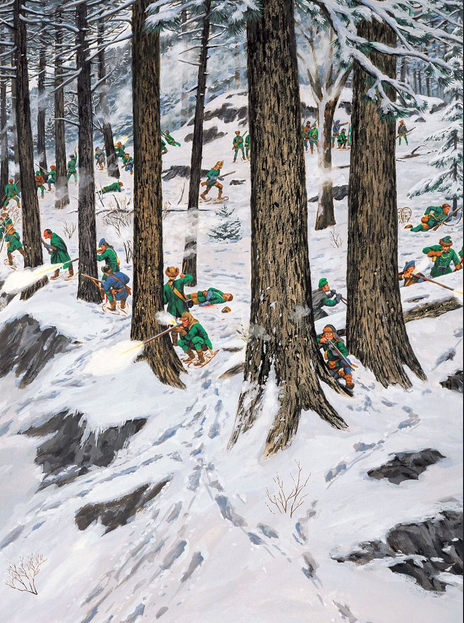
Attempts to outflank them were repeatedly made, and were gallantly repulsed. The Rangers were also hard pressed in front, but having the advantage of the ground, and being sheltered by large trees, they maintained a constant and effective fire until darkness put an end to the conflict, when the enemy retired. Rogers having been wounded, and Spekeman killed, the command devolved upon Stark.
While the fight was fiercest, a ball pierced Rogers’s wrist. A stream of blood gushed out. It had to be stopped or he would bleed to death. Rogers’s hair was braided in a queue behind. One of the Rangers cut it off with his hunting-knife, and Rogers thrusting it into the wound stopped the flow of blood.
After receiving this second wound, Rogers advised a retreat, but Stark declared that he had a good position and would fight until dark, and then retreat; that in such a course lay their only safety, and that he would shoot the first man who fled. While he was speaking, a bullet struck the lock of his gun, rendering it useless. Seeing a Frenchman fall at the same moment he sprang forward, seized his gun, and returning to his tree continued the action.
While the Rangers were defending their position on the crest of the hill, Stark observed that several balls struck near him from a particular direction. A moment afterwards he discovered an Indian stretched at full length upon a rock, behind a large tree. Getting his gun in readiness, as the Indian rose for another shot at him, it was instantly levelled and discharged, and the savage rolled from the rock into the snow, pierced through the head by the bullet.
At nightfall Stark drew off his men in good order, and by marching all night reached Lake George early next morning. As the wounded were unable to proceed farther, Stark volunteered to procure assistance from Fort William Henry. He reached it that evening, performing the journey of forty miles upon snow-shoes, the snow being four feet deep upon a level. Sleds were immediately dispatched, and the wounded safely transported to the fort.
Stark’s decision, prudence, and courage saved the Rangers from defeat in this instance, and contributed greatly to the subsequent success and celebrity of the corps. He was promoted to the captaincy made vacant by the loss of Captain Spekeman.
This was a costly victory for the Rangers, who lost, in killed, wounded, and prisoners, more than one-third of their number. The number of the enemy was two hundred and fifty, of whom one hundred and sixteen were killed and wounded.
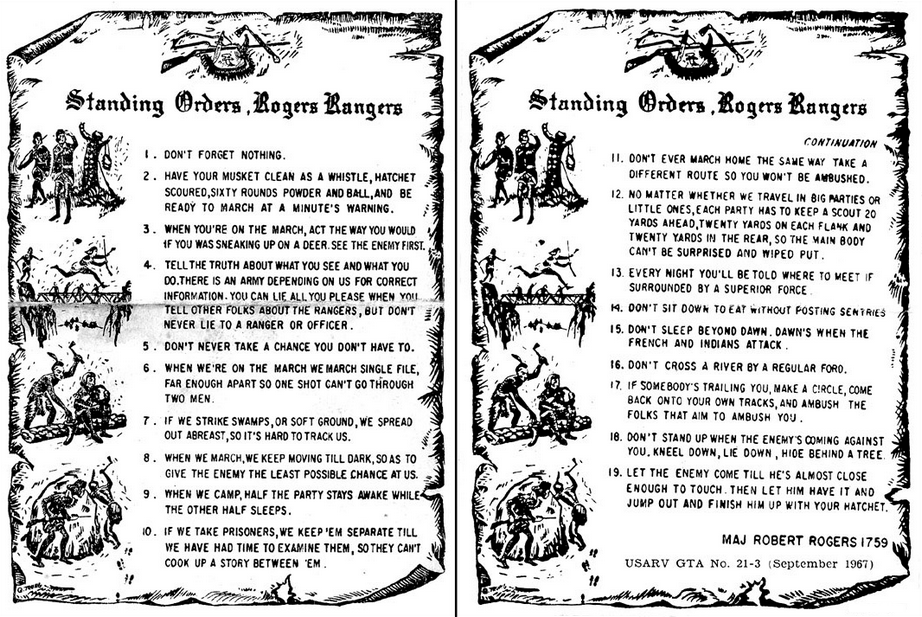
Skilful and brave as were the Rangers, they were not always successful. The French partisans, under good leaders, with their wily and formidable Indian allies well versed in forest warfare, on one occasion inflicted dire disaster upon them.
Near Fort Ticonderoga, Rogers, with one hundred and eighty men, attacked and put to flight a party of Indians, inflicting upon them a severe blow. This, however, proved to be only a small part of a force which, under Durantaye and De Langry, French officers of reputation, was fully prepared to meet the Rangers, of whose movements they had been thoroughly informed beforehand.
The Rangers had thrown down their packs, and were scattered in pursuit of the flying savages, when they were suddenly confronted by the main body of the enemy, of whose presence they were wholly unsuspicious. Nearly fifty of the Rangers fell at the first onslaught, the remainder retreating to a position in which they could make a stand. Here they fought with their accustomed valor, and more than once drove back their more numerous foes. Repeated attacks were made upon them both in front and on either flank, the enemy rallying after each repulse, and manifesting a tenacity and determination equal to that of the Rangers.
The fight had lasted some time, when a body of two hundred Indians was discovered ascending a hill on the right, in order to gain the rear of the Rangers. Lieutenant Phillips, with eighteen men, reached it before them and drove them back. Lieutenant Crufton, with fifteen men, was ordered to anticipate a similar movement in another quarter. The enemy now pressed so closely on their front that the opposing parties were often intermingled, and in general not more than twenty yards asunder.
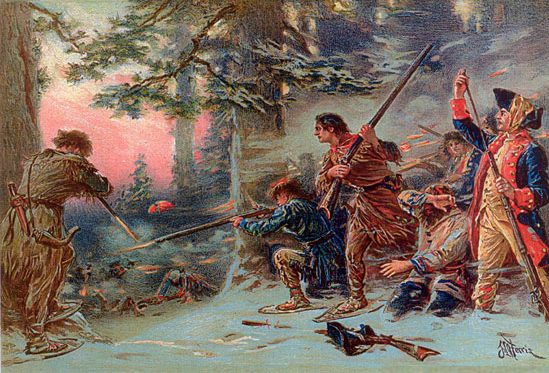
This unequal contest had continued an hour and a half, and the Rangers had lost more than half their number. After doing all that brave men could do, the remainder retreated in the best manner possible—each for himself. A singular circumstance connected with this battle was, that it was fought by both sides upon snow-shoes.
In the pursuit that followed, Rogers made his escape by outwitting the Indians who pressed closely upon him—such, at least, is the tradition. The precipitous cliff near the northerly end of Lake George, since called Rogers’s Rock, has on one side a sharp and steep descent hundreds of feet to the lake. Gaining this point, Rogers threw his rifle and other incumbrances down the rocks. Then unbuckling the straps of his snow-shoes, and, turning round, he refastened them, the toes still pointing towards the lake. This was the work of a moment. He then walked back from the edge of the cliff into the woods, and disappeared just as the Indians, sure of their prey, reached the spot. To their amazement, they saw two tracks towards the cliff, none from it, and supposed that two Englishmen had thrown themselves down the precipice, preferring to be dashed to pieces rather than be captured. Soon a rapidly receding form on the ice below attracted their notice, and the baffled savages, seeing that the redoubtable Ranger had safely effected the perilous descent, gave up the chase, fully persuaded that Rogers was under the protection of the Great Spirit.
The retreating Rangers reached Lake George that evening, and an express was despatched to the fort for assistance. The men, having lost their knapsacks, passed an extremely cold night, without fire or blankets. Proceeding up the lake in the morning, they were met by Stark, who was not in the engagement, bringing to their relief provisions, blankets, and sleds. This timely assistance enabled them to reach Fort Edward in safety.
One fine morning in the following August, Rogers and Israel Putnam, a provincial officer from Connecticut, with five hundred men, were in the vicinity of Fort Anne—a post about midway between Ticonderoga and Fort Edward—watching the motions of the enemy. The French, under the celebrated partisan Marin, were also on the lookout for them, and only a mile and a half distant.
In a spirit of false emulation, and in disregard of that prime virtue of the Ranger—caution in the presence of an enemy—Rogers, before marching, practised firing at a mark with a British officer. The sound reached the ears of the vigilant Marin, who hastily formed an ambuscade at the point where the Rangers soon afterwards emerged from a dense thicket into the open woods. Putnam was in front, Captain Dalzell, with some British regulars, was in the centre, while Rogers brought up the rear.
Just as Putnam entered the forest the enemy rose, and with discordant yells and whoops began the attack. He halted and returned the fire, his men scattering, sometimes fighting aggressively in open view, and sometimes individually under cover, taking aim from behind each tree. Dalzell carne promptly to his support, Rogers contenting himself with protecting the flanks and rear. After a hard struggle the enemy were driven from the field, leaving about ninety dead.
Early in the fight a rush was made upon the Rangers, and Putnam’s fusee unfortunately missed fire, just as he was confronted by a large and powerful savage. With uplifted hatchet and exultant yell the warrior sprang forward, compelled him to surrender, and then disarming him and binding him to a tree returned to the conflict.
A turn in the tide of battle soon brought this tree directly between the two parties, and it was pierced by many of the balls which flew incessantly from either side. Putnam’s clothes were riddled with shot-holes, but not a bullet touched his person. In this uncomfortable situation, unable to stir hand or foot, or even to incline his head, he remained more than an hour, when, on the retreat of the enemy, he was unbound and carried off by his captor.
At one time, when the Indians had gained ground, a young brave amused himself by throwing his tomahawk as near Putnam’s head as possible without hitting it. While engaged in this pleasant occupation, the weapon several times struck the tree within a hair’s-breadth of the mark. He tired at length of this cruel sport, and a more savage Frenchman approached and leveled his musket within a foot of Putnam’s breast. Fortunately it missed fire. In vain Putnam claimed the consideration due to a prisoner of war; the dastardly wretch gave him a cruel blow on the jaw with the butt end of his piece, and then left hint to his fate.
At some distance from the scene of action he was stripped of his coat, vest, stockings, and shoes, loaded with as many of the packs of the wounded as could be piled upon him, strongly pinioned, and his wrists tied as tightly together as they could be pulled with a cord. When, after a long and toilsome march, the party halted, his naked feet were torn and bleeding, and his hands were immoderately swollen from the tightness of the ligature.
Exhausted with bearing a burden beyond his strength, and frantic with pain, he entreated the savages either to kill him at once or loose his hands. A French officer interposed; his hands were unbound, and his load lightened. Just then his captor, who had been absent, returned, gave him a pair of moccasins, and expressed great indignation at the cruel treatment of the prisoner. He also gave him some hard biscuit, which, as he could not chew, on account of the blow inflicted by the Frenchman, the more humane savage soaked in water. This and some bear’s meat lie managed to suck through his teeth, and allay his extreme hunger.
On encamping for the night, the savages, besides other outrages, had the barbarity to inflict upon him a deep wound with a tomahawk in his left cheek. They had determined to roast him alive, in accordance with their savage custom with captives taken in battle.
Leading him into the forest, he was stripped, bound fast with green withes to a sapling, and dry brush, with other fuel, was piled at a short distance in a circle around him. Fierce yells and savage screams accompanied this labor and added to the horror of the scene. The flames were kindled, but were almost extinguished by a sudden shower. Soon the blaze increased, and Putnam began to feel the scorching heat. He could just move his body, and often shifted sides as the fire approached—a sight which afforded the greatest diversion to his inhuman tormentors, as he could perceive by their yelling, gesticulating, and dancing.
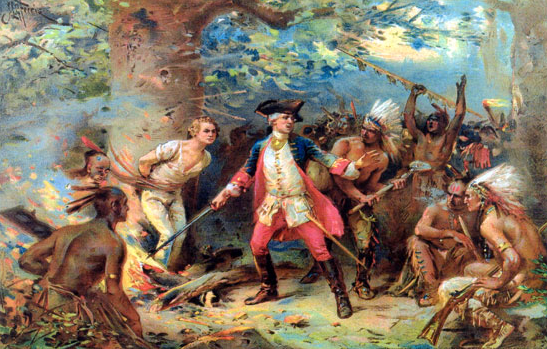
Only a short time before he had been nearly roasted in a successful and heroic effort to save the powder-magazine at Fort Edward, after its outer planking had been burned through; and it had taken him a month to recover from the effects of that fierce battle with the flames. This time he had given up all hope of escape from the fiery fate that enveloped him, when a French officer, rushing through the savage throng, scattered the burning brands and unbound the victim. It was Marin himself, to whom a humane Indian had hastened with the tidings, just in time to save him, and who remained with him and protected him until the return of his captor, who it seems had not been present at his attempted torture.
This savage, while treating his captive with humanity, took every precaution to prevent his escape. His mode of securing him at night was most ingenious. Lying on his back upon the ground, Putnam’s arms and legs were stretched apart, and each fastened to a sapling. Then a number of tall but slender poles were cut, which with some long bushes were laid across his body from head to foot. On these, at each side, lay as many Indians as could conveniently bestow themselves. In this disagreeable and painful posture Putnam passed the long and dreary night but, as he afterwards related, he could not, in spite of his discomfort and suffering, help smiling at the thought of what a ludicrous group for a painter this scene presented. At Ticonderoga he was placed under a French guard and properly treated. Transferred to Montreal, he was finally exchanged through the exertions of Colonel Peter Schuyler, a fellow-prisoner.
Israel Putnam, who rose to be the senior major-general in the Revolutionary army, and next in rank to Washington, was born at Salem, Massachusetts, in 1718. He had the slight education of a farmer’s son at that day, but possessed a vigorous frame, great bodily strength, hardiness, and activity, together with no ordinary share of courage, enterprise, and perseverance. He was a hero, not only by constitution and temperament, but by the nobler impulses of love of country, and an invincible devotion to duty. As a captain in Lyman’s provincial regiment, in 1755, he became connected with Captain Rogers, of the Rangers, and having himself a similar command, they were frequently associated together in scouting and other service.
On the first occasion of the kind it was Putnam’s good-fortune to save the life of Rogers, who, with himself—their men being concealed at a little distance—was engaged in the hazardous operation of reconnoitering the works at Crown Point, in the midst of a forest filled with hostile Indians. While thus engaged, in the early morning, Rogers accidentally encountered a stout Frenchman, who instantly seized his fusee with one hand and with the other attempted to stab him, while he called to the guard for assistance. Putnam, perceiving the imminent danger of his friend, hastened to the spot, and with the butt end of his piece laid the Frenchman dead at his feet. Speedily rejoining their party, they made good their retreat.
Putnam was present at the siege of Montreal, in 1760, at the capture of Havana, in 1762, and in 1764 was a colonel in Bradstreet’s expedition against the western Indians. His military reputation was of great service to the patriot cause at the outset of the Revolution, inspiring his country-men with the confidence they so much needed to enable them to confront the great military power they were then defying.
He was a conspicuous figure at the siege of Boston, and at Bunker Hill seems to have exercised, at the redoubt, the breastwork, the rail-fence, and in the retreat, all the functions of a commanding officer. While commanding at the Highlands of New York he made the judicious selection of West Point as the site of a fortress. While posted at Reading, Connecticut, in 1778, with only a picket-guard, he was suddenly attacked by the British troops, and escaped by plunging down a precipice where the dragoons in pursuit of him dared not follow. One of their bullets having pierced his hat, Tryon, their commander, by way of compensation, sent him soon afterwards a complete suit of clothes. He had an attack of paralysis in the fall of 1779, and died at Brooklyn, Connecticut, May 29, 1790. Putnam was a good executive officer, but was more brave than prudent. Though wanting in dignity, he possessed a large share of those nobler attributes, humanity and generosity.
Few men ever encountered such a variety of dangers, or faced death in so many different forms. From the fierce she-wolf in her den—a story with which all boys are familiar; the burning powder-magazine at Fort Edward; the fiery torture at the stake; the tomahawk and the bullet of the concealed savage whose forest haunts he invaded; close and bloody contests with Indians and Frenchmen in the Old French War; at the Havana, fighting at the same time the Spaniard and the pestilence, which proved fatal to so many of his companions; and lastly at Bunker Hill and on other Revolutionary fields—a conspicuous target for British bullets. With the exception of the singeing he got at Fort Edward, and the cruelties inflicted upon him while a prisoner, he escaped, as by a miracle, from all these manifold perils without a wound.
We come now to the last exploit of this famous corps of Rangers. The village of the St. Francis Indians was situated in the heart of Canada, midway between Montreal and Quebec. This tribe was wholly in the interest of the French, and had for a century past harassed the New England frontier even in times of peace. During the past six years they had killed and carried away more than six hundred persons, and it was determined by Amherst, the British commander-in-chief, that a signal chastisement should be inflicted upon them. To this arduous service the Rangers were assigned.
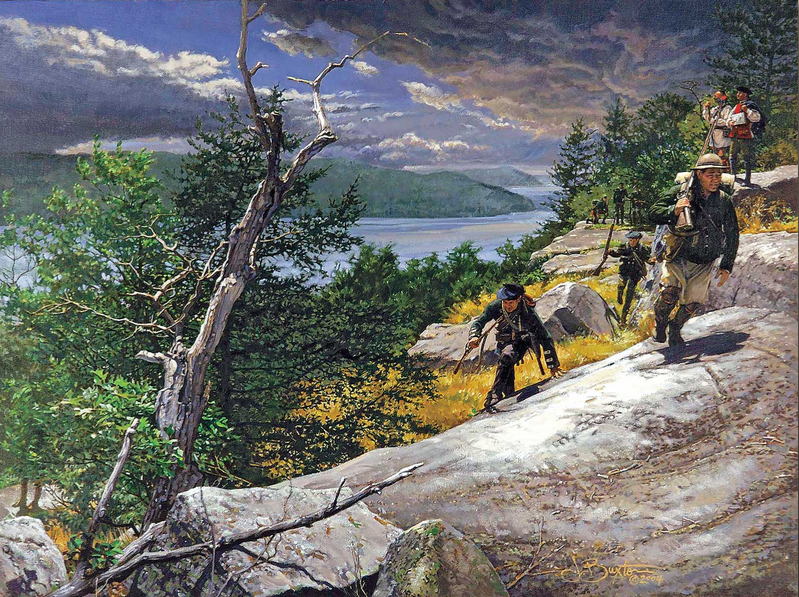
The march through two hundred miles of unbroken wilderness was one of great difficulty and no slight peril. The boats of the Rangers, in which were the provisions for their home journey, had been left at Missisqui Bay, and they soon learned that these had fallen into the hands of the enemy, who were following in their track. This was a serious blow, and threatened the ruin of their enterprise, but they determined to push on, and accomplish their object by outmarching their pursuers.
For nine days their route lay through a spruce-bog, a portion of which was covered with water a foot deep. When they encamped at night, boughs were cut from the trees, and a kind of rude hammock constructed to keep them from the water. Their daily march began a little before daybreak, and continued until after dark at night. The tenth day after leaving the bay found them at a river fifteen miles north of St. Francis, which they were compelled to ford against a swift current. To accomplish this the tallest men were put up stream, and holding by each other the party crossed in safety.
Twenty-two days after leaving Crown Point, Rogers’s party, numbering one hundred and fifty-two, men and officers, came in sight of the Indian town. Upon climbing a tree it was revealed to them at a distance of three miles. On reconnoitering the village, the Indians were seen to be engaged in a “high frolic”—a wedding celebration, as it proved—and were dancing and enjoying themselves as was customary upon such occasions.
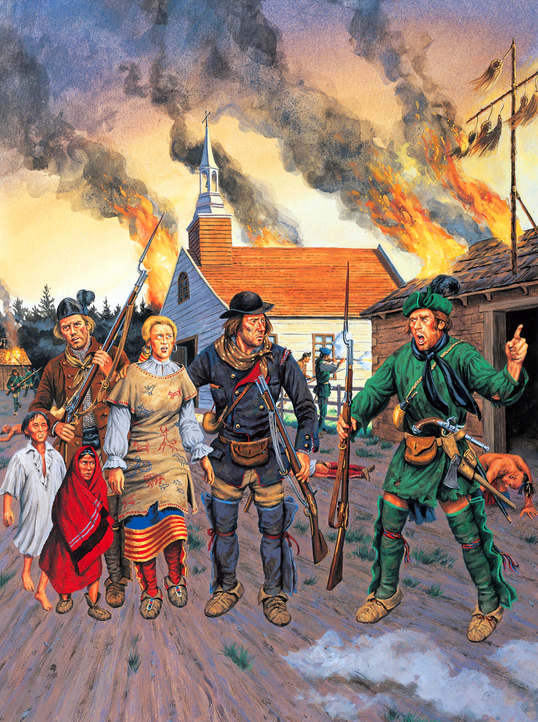
Half an hour before sunrise the Rangers rushed upon the sleeping village. The surprise was complete. The Indians had no time to arm themselves, and in a few minutes the work was done. Two hundred of them were killed, some women and children were captured, five English prisoners released, and the village was wholly consumed. Six hundred human scalps were found hanging upon poles over the doors of the wigwams.
For their subsistence on the march home, the Rangers loaded themselves with corn, the only provision to be found. From the prisoners they learned that three hundred French and Indians were close at hand, addition to the party already known to be in pursuit. It was at once determined to return by a different route from that by which they came, and that by the Connecticut River to Number Four (Charlestown, N. H.) was selected. The annals of the wilderness contain no more thrilling chapter than that which records their sufferings during this terrible journey. Hunger and privation of every kind—these they were familiar with; a vengeful foe following upon their track—even this inspired no especial dread; but starvation! That was an enemy before whom the stoutest and bravest quailed. Some of the details of their sufferings are too shocking for repetition.
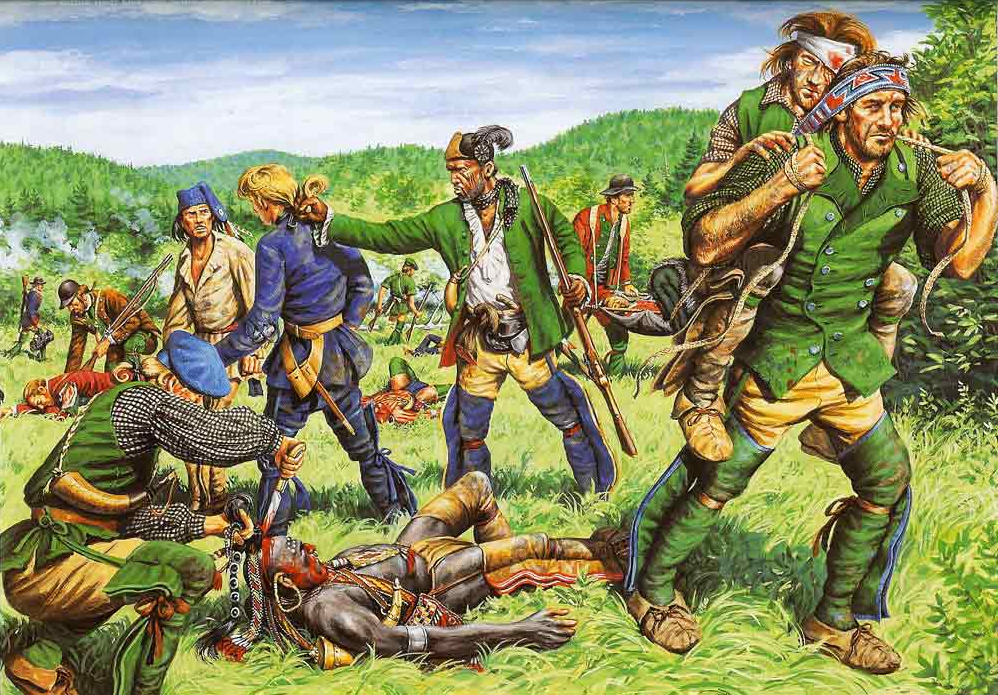
After repulsing repeated attacks, Rogers at length turned upon his pursuers, and dealt them a punishment so severe as to stop further assaults, though the Indians continued to follow him with the tenacity of bloodhounds.
For eight days the Rangers kept together, but at Lake Memphrenragog the scarcity of food compelled them to separate into companies, with guides to each. The place where they were to meet was at the mouth of the Ammonoosuck River, to which point supplies had been directed to be sent. On arriving at the Coos Intervales, worn down with hunger and fatigue, they found, to their dismay, that the officer who had been despatched with provisions to their rescue had returned, after waiting but two days, carrying the supplies with him, and that he had been gone hardly two hours!
This was a terrible disappointment. Says Rogers: “We found a fresh fire burning in his camp, and fired guns to bring him back, which he heard, but would not return, supposing we were an enemy. In this emergency I resolved to make the best of my way to Number Four, leaving the remainder of the party—now unable to proceed farther—to obtain such wretched subsistence as the wilderness afforded until I could relieve them, which I promised to do in ten days.”
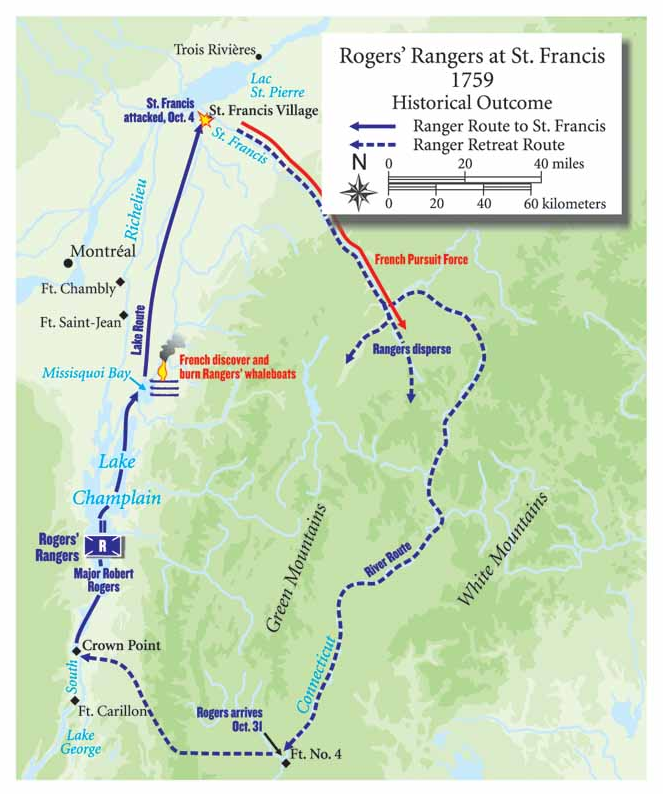
With great difficulty Rogers reached his destination, and on the tenth day after his departure relief reached his men at Coos, as he had promised. Upon the arrival of the survivors at Crown Point, it was ascertained that the Rangers had lost in this retreat three officers and forty-six men. Two of the parties had been overtaken, and most of the men composing them killed or captured by the enemy.
Great as were the sufferings of the other parties, they were as nothing compared with those of Lieutenant George Campbell and his companions. For four days they were without subsistence of any kind whatever. Their misery was so aggravated, by their not knowing whither the route they were following would lead them, that some lost their reason. What leather they had in their cartridge-boxes they had reduced to a cinder and greedily devoured, when relief finally reached them.
The Rangers took part in the final campaign of 1760, which ended in the conquest of Canada, and, in a skirmish with the rear-guard of the retreating French, fired the last hostile guns of the war. By order of General Amherst they were sent to take possession of Detroit, and the other western posts ceded by the French.
Rogers’s subsequent career was not particularly creditable to him. While Governor of Michilimackinac, in 1766, he was arrested for plotting to give it up to the Spaniards, and sent in irons to Montreal for trial. He managed to be acquitted of the charge, and on visiting England, in 1769, was presented to the King. Returning to America on the breaking out of the Revolution, in 1775, he was suspected by Washington of being a spy, and prohibited from entering the American camp. Arrested in June, 1776, he was soon released by order of Congress, and at once openly joined the British in violation of his parole of honor. Obtaining a commission as colonel in the British service, he raised a corps known as the Queen’s Rangers, afterwards commanded by Colonel Simcoe, and famous for its exploits. Rogers, however, gained no laurels while at its head, and came near being captured in an attack upon an American outpost near Mamaroneck, in New York. He soon afterwards returned to England, where he died near the close of the century.

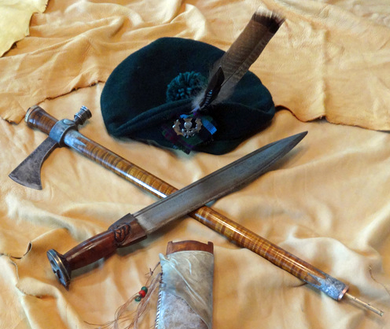

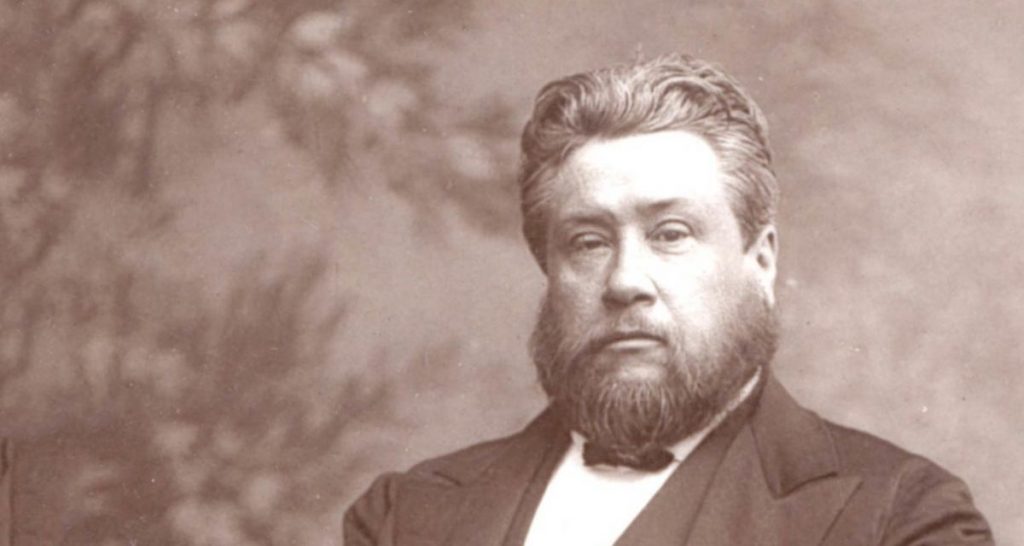
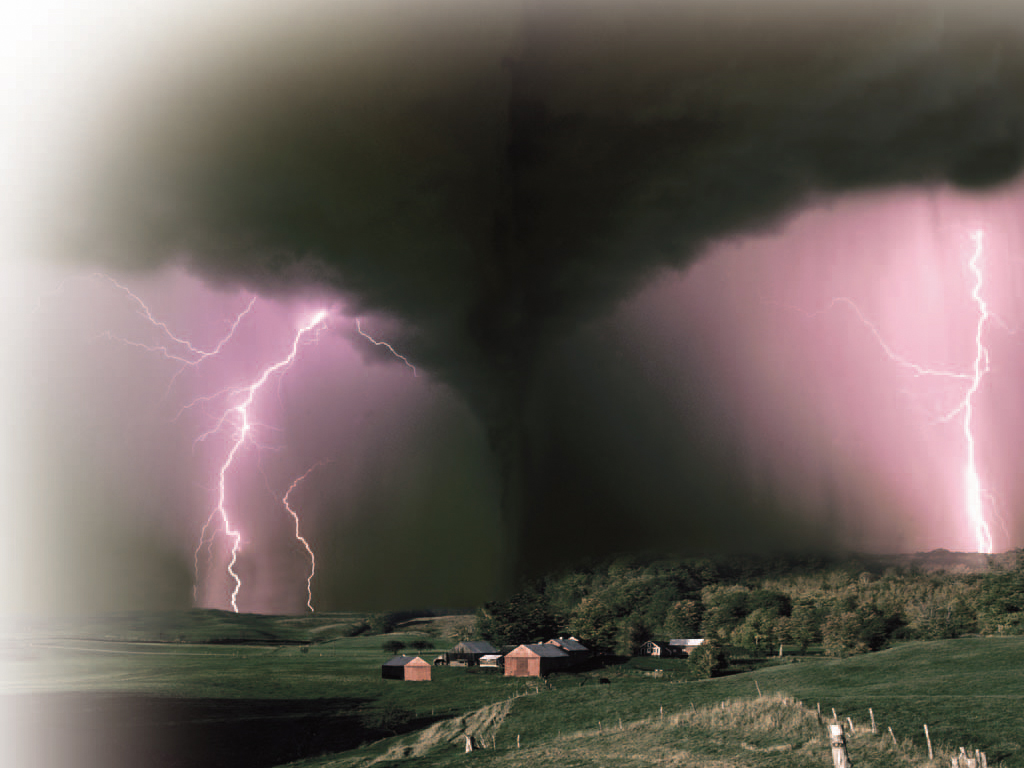





A most fascinating piece of our history. Men like Roger’s don’t seem to be amongst us very much, any more.
My great-great-great-great-great grandfather, Jonas Groves, was in Rogers’ Rangers, in which he enlisted in 1761.